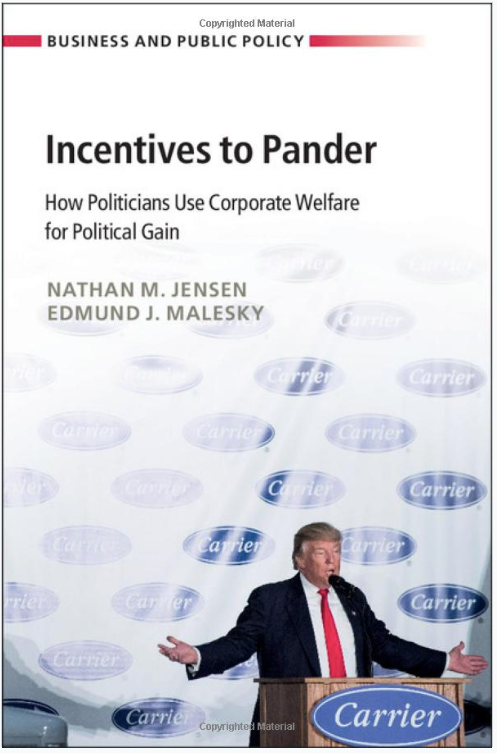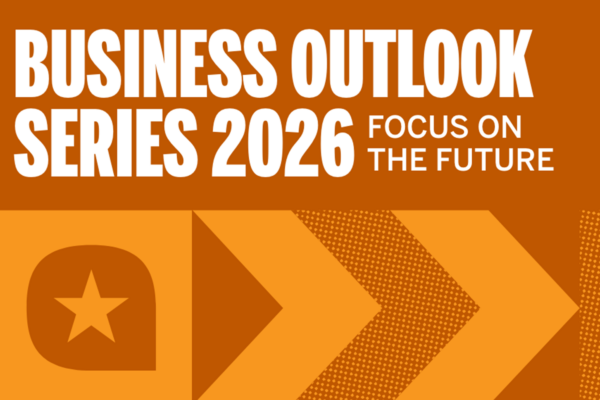Why Politicians Spend Billions on Wasteful Economic Development Incentives — and Love It
Richard Florida, the bestselling urban development author and senior editor at The Atlantic, talked with Professor Nathan Jensen about his new book, Incentives to Pander: How Politicians Use Corporate Welfare for Political Gain.
By Richard Florida, originally published in CityLab

One of the most troubling trends in urban development is the sharp rise in the use of economic development incentives. In 1999, 68 percent of U.S. cities and states used financial incentives to attract capital; by 2009, that number had risen to a staggering 95 percent.
In 2016, Nevada handed Tesla more than $1 billion for a battery factory. Later that year, Oregon gave Intel $2 billion for a new semiconductor chip plant. Last year, Wisconsin gave Foxconn $3 billion, and some states are offering more than $7 billion to lure Amazon HQ2. Today, nearly all American cities and states offer incentives in some form to attract business, even though the overwhelming bulk of research on the subject shows that incentives are an ineffective waste of taxpayer money.
In their new book Incentives to Pander: How Politicians Use Corporate Welfare for Political Gain, Nathan Jensen, a professor at The University of Texas at Austin, and Edmund Malesky, a professor of political science at Duke University, take a deep dive into what motivates politicians to offer these increasing — and increasingly unproductive — incentive packages. Jensen got interested in incentives while studying the effect of large-scale direct foreign investment in developing countries.
What he found especially curious is that states and cities in the United States — the world’s richest and arguably most technologically advanced country — were offering packages that were even bigger than the ones developing economies were using to lure factories and jobs.
We recently spoke with Jensen about the book, his and Malesky’s research, and the incentive mania over Amazon HQ2. Our conversation has been edited for length and clarity.
Talk a little bit about the history of incentives. How long has this been going on?
The earliest we could find was an 1116 Italian incentive for a textile manufacturer. In the U.S., it’s Alexander Hamilton who had the first manufacturing incentive. The idea of giving cash or tax abatements definitely isn’t new.
When did we start to see the really big growth in incentives?
In 1999, about half of the cities offered incentives. By 2009, it’s well over 90 percent. But we also see the rise of “megadeals.” In some cases, we see fewer deals, but more going for the big fish. With Amazon HQ2 and Foxconn, the size of these megadeals is incredible. You see the big boom recently, in the last 10–15 years, of the size of incentives.
What lies behind the rise of these megadeals?
It’s some of the most visible investment coming to a city, and politicians are just throwing everything they possibly can at [companies] to get this big marquee investment, even though a much more effective way is to grow local businesses. But it’s an immediate, really big impact. That’s what makes the megadeals so enticing. It doesn’t have to be headquarters. A politician can point at the big factory in their community and say, “Look what I’ve done.” And in some sense, that seems like a winning political strategy.

You title your book Incentives to Pander. Who is pandering to whom? Is it more that politicians are pandering to corporations, or that politicians, mayors, and governors are pandering to their voters? Or is it both?
There are consultants, there are companies, there are elected officials, there are NGOs. There are a lot of different actors at fault here. But what we focus on is politicians pandering to voters. These politicians are offering these incentives not in smoke-filled rooms, but in ribbon-cutting ceremonies. They are trying to show voters that they are doing something to attract investment, even if they believe that incentives actually might not be effective.
It seems to me there’s a political risk in giving these huge incentives. People can say, “Look, you’ve given away the store to the fat cats.” But your book makes a very strong case that the benefits, at least as perceived by politicians, outweigh the risks.
If you provide an incentive, you can actually get more credit for that. It’s the opposite of what most economists would say. And it works even if the company doesn’t come. It’s an incredibly effective way to deflect blame, saying, “I put my best offer on the table. Clearly the company made the wrong choice, but it’s not my fault.”
“Politicians often claim that these incentives pay for themselves. They’re often very careful in what details they provide. Elected officials actually provide very little cost-benefit analysis. So you see less scrutiny of these deals.”
“If you provide an incentive, you can actually get more credit for that. It’s the opposite of what most economists would say.”
Before reading your book, I thought this was just a giant American problem. But you talk about incentives being used in all sorts of places around the world.
Yes, we also look at non-democratic regimes. And we see local government officials pandering to higher government officials, meaning they are trying to show, in places like Vietnam and Russia, that they are bringing investment to their district, because that’s how you get promoted. Even if you take the corporate pressure off the table, there are strong motivations for politicians to use these incentives.
The U.S. is an outlier in some sense. There is this incredible competition across American states for investment. We’re just shifting investment across locations within the U.S., not attracting new investment. Brazil is another place that does have this massive competition sub-nationally. But in most other countries, we see it at the national level. Central governments are providing incentives, and in some cases like the UAE or China, very large incentives. This is a global phenomenon.
Are state and local incentive packages in the U.S. as big or bigger than those offered by national governments elsewhere?
Some of the state packages are just massive, bigger than country packages. Some countries in the European Union are limited by E.U. restrictions and rules, which put limits on what a local or national government can offer. In that sense, the E.U. looks very different from the United States.
Read the rest of Florida’s interview with Nathan Jensen about the use of fiscal incentives for political gain, including the reasons for secrecy surrounding high-profile deals such as Amazon HQ2. Why Do Politicians Waste So Much Money on Corporate Incentives? on CityLab.
Nathan Jensen is a professor in the Business, Government, and Society Department at McCombs School of Business and is a faculty affiliate of the UT Energy Institute. Jensen received his Ph.D. from Yale University.
Richard Florida is a co-founder and editor at large of CityLab and a senior editor at The Atlantic. He is a university professor and director of cities at the University of Toronto’s Martin Prosperity Institute and a Distinguished Fellow at New York University’s Schack Institute of Real Estate.
About this Post
Share:

